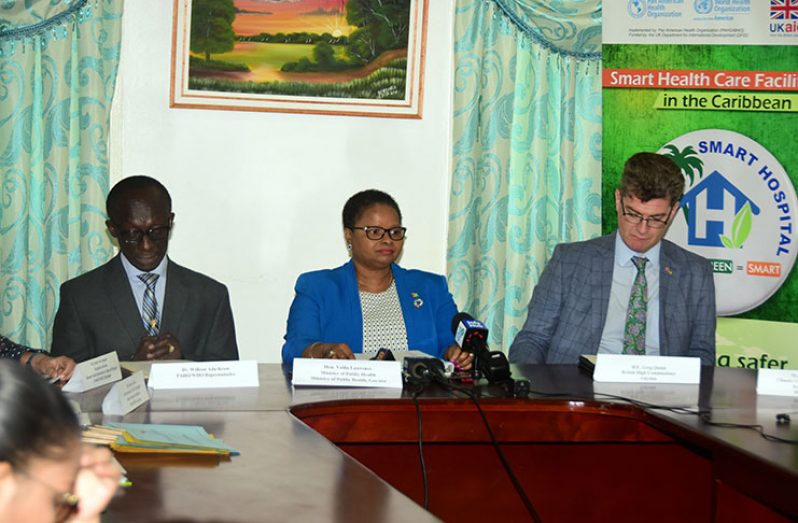FIVE hospitals in Guyana will be upgraded to withstand natural disasters under the United Kingdom (UK) funded ‘SMART Health Care Facilities Project.’

Public Health Minister, Volda Lawrence; PAHO/WHO Representative, Dr William Adu-Krow and British High Commissioner Greg Quinn, were among officials who launched the project in the boardroom of the Public Health Ministry.
With an injection of approximately US$4.175M, the Diamond Diagnostic Centre, the Mabaruma Regional Hospital, the Leonora Cottage Hospital and the Lethem Regional Hospital will be retrofitted as part of the SMART Health Care Facilities in the Caribbean Project. Depending on the availability of funding, the Paramakatoi Health Centre will also be retrofitted.
Minister Lawrence, in putting the initiative into perspective, explained that two years ago DFID included Guyana in its SMART Hospitals Initiative, which will see healthcare institutions being designed to help reduce mortality, morbidity and economic losses from natural disasters.
“…Under the DFID pact, we are not building any new facilities, but retrofitting some existing hospitals under the terms of the agreed compact,” she told reporters during the launch, emphasising that when completed, the identified hospitals will be well equipped to withstand the various effects of climate change.
It was noted that the identified hospitals at Diamond, Mabaruma, Leonora and Lethem were selected on the basis of strict selection criteria, agreed under a tripartite arrangement brokered among DFID, PAHO/WHO and the Public Health Ministry. A total of 71 health facilities were assessed before the hospitals were shortlisted.
“When evaluated using the Health Safety Index (HSI), almost all of the selected institutions received a classification of ‘C’, meaning that urgent intervention measures are needed. Put forthrightly, the hospitals’ current safety levels are inadequate to protect the lives of patients and staff during and after a disaster. Since none of them obtained the minimum score required to be classified as a green facility, then all must be retrofitted,” the Public Health Minister explained.
In addition to being redesigned to withstand natural disasters, the hospitals will become energy- efficient and this would result in a slash in operating costs.
High Commissioner Quinn, in his address, said under the 38 million-pound UK project, the identified health facilities in the region will become more efficient in the utilisation of resources and at the same time more resilient to natural disasters.
He noted that the project, which will wrap up in 2020, comes at a critical time, pointing to the excessive overtopping and high tide which resulted in the flooding of the Leonora Cottage Hospital. When the hospitals are retrofitted, the High Commissioner gave the assurance that they will be able to operate during and after natural disasters such as floods, in the case of Guyana.
“The refurbished facilities will be more resilient and more efficient. They will also be cheaper to run…and it is our hope that the ministry will be able to put those savings back into the respective facilities to ensure that future maintenance needs are met,” he posited.
Dr Adu-Krow, in his address, pointed out that healthcare facilities are considered ‘smart’ when their structural and operational safety is linked with green interventions, at a reasonable cost-to-benefit ratio. The UK-funded SMART Health Care Facilities Project, is one such initiative that facilitates such interventions.
“A ‘safe hospital’ is one whose services remain accessible and functions at maximum capacity and in the same infrastructure, during and immediately following the impact of a major event…In “green” hospitals, air quality improves, water and energy costs decline, and people’s working conditions improve through enhanced physical access to hospitals, improved access to safe water and improved safety conditions,” the PAHO/WHO representative explained.
He noted too that in addition to the 71 health facilities which were assessed by 25 professional government officers, including engineers, training sessions were also conducted. The 25 government officers were trained ahead of the assessment. Additionally, a batch of 57 contractors were educated about the project and the procurement procedures to be followed.
“Currently, we are evaluating bids from design firms and going forward, the project will include Contingency Plan Training, Conservation Plan Training, Training for Maintenance Staff for the facilities selected, Knowledge, Attitude and Practice Survey, Occupation Satisfaction Survey, and Consultation with the Community on the design,” Dr Adu-Krow disclosed.
One of the objectives of the project, Dr Adu-Krow added, is that the concept of Smart Facilities will be adopted by other sectors, such as Education and Tourism.
In total, 50 health facilities in Grenada, St Vincent and the Grenadines, Saint Lucia, Dominica, Belize, Guyana and Jamaica will be retrofitted. It will conclude in 2020.
Regional Advisor, Disaster Risk Reduction & Special Projects PAHO/WHO (Barbados), Dr Dana Van Alphen; International PAHO Consultant – SMART Hospitals Initiative (Guyana), Rawle Jordon; and Climate Change and Disaster Risk Reduction Adviser (DFID Caribbean), Simone Banister, were among the other officials present.




.jpg)










